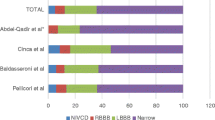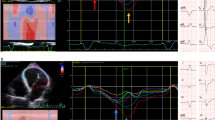Abstract
Purpose
Response to cardiac resynchronization therapy (CRT) is well-established in patients with typical left bundle branch block (LBBB) but modest or even negative in those with intraventricular conduction delay (IVCD). However, IVCD pattern is heterogeneous, and it is possible that QRS patterns may also respond to CRT.
Methods
Consecutive baseline ECGs of 239 patients implanted between 2007 and 2010 with CRT were analyzed. ECGs were classified into the following three groups: (a) typical LBBB (TLBBB) according to accepted guidelines (n = 67); (b) IVCD with LBBB pattern criteria in V1, 1, and aVL but with QS or rS in V5–V6 which we defined as atypical LBBB (ALBBB) (n = 74); and (c) all other IVCD (OIVCD) patterns (n = 98). Endpoints were 2 years mortality and echocardiographic response, defined as a decrease of ≥ 10% in indexed LVESV or an increase of ≥ 5% in left ventricular ejection fraction at 1 year of follow-up.
Results
Baseline clinical characteristics were similar among all the three groups. Rates of echocardiographic response were lower among those with OIVCD compared to those with LBBB and ALBBB (50% vs. 75% and 72%, respectively, p = 0.01 for both comparisons). A multivariable model showed a lower likelihood of echocardiographic response in OIVCD [HR = 0.40; (0.16–0.98)] and a similar likelihood in ALBBBB [HR = 0.98; (0.40–2.40)] compared to TLBBB. Cumulative 2-year survival was 88% in ALBBB, 86% in TLBBB, and 76% in OIVCD (p value = 0.011).
Conclusion
Patients with ALBBB may have a favorable echocardiographic response to CRT and display similar survival rates to typical LBBB. This subgroup of IVCD should be considered for CRT.
Condensed abstract
Atypical left bundle branch morphology defined as QS or rS in lead V1, broad R waves in lead I, and aVL but with QS or rS in V5–V6 is associated with favorable echocardiographic response to CRT and displays similar survival rates to typical LBBB patients.



Similar content being viewed by others
References
Cleland JG, Abraham WT, Linde C, Gold MR, Young JB, Claude Daubert J, et al. An individual patient meta-analysis of five randomized trials assessing the effects of cardiac resynchronization therapy on morbidity and mortality in patients with symptomatic heart failure. Eur Heart J. 2013;34:3547–56.
Moss AJ, Hall WJ, Cannom DS, Klein H, Brown MW, Daubert JP, et al. Cardiac-resynchronization therapy for the prevention of heart-failure events. N Engl J Med. 2009;361:1329–38.
Zareba W, Klein H, Cygankiewicz I, Hall WJ, McNitt S, Brown M, et al. Effectiveness of cardiac resynchronization therapy by QRS morphology in the multicenter automatic defibrillator implantation trial-cardiac resynchronization therapy (MADIT-CRT). Circulation. 2011;123:1061–72.
Lund LH, Benson L, Stahlberg M, Braunschweig F, Edner M, Dahlstrom U, et al. Age, prognostic impact of QRS prolongation and left bundle branch block, and utilization of cardiac resynchronization therapy: findings from 14,713 patients in the Swedish Heart Failure Registry. Eur J Heart Fail. 2014;16:1073–81.
Ponikowski P, Voors AA, Anker SD, Bueno H, Cleland JGF, Coats AJS, et al. 2016 ESC guidelines for the diagnosis and treatment of acute and chronic heart failure: the task force for the diagnosis and treatment of acute and chronic heart failure of the European Society of Cardiology (ESC) developed with the special contribution of the Heart Failure Association (HFA) of the ESC. Eur Heart J. 2016;37:2129–200.
Tracy CM, Epstein AE, Darbar D, DiMarco JP, Dunbar SB, Estes NAM III, et al. 2012 ACCF/AHA/HRS focused update of the 2008 guidelines for device-based therapy of cardiac rhythm abnormalities: a report of the American College of Cardiology Foundation/American Heart Association task force on practice guidelines. J Am Coll Cardiol. 2012;60:1297–313.
Dickstein K, Vardas PE, Auricchio A, Daubert JC, Linde C, Mc Murray J, et al. 2010 Focused update of ESC guidelines on device therapy in heart failure: an update of the 2008 ESC guidelines for the diagnosis and treatment of acute and chronic heart failure and the 2007 ESC guidelines for cardiac and resynchronization therapy. Developed with the special contribution of the Heart Failure Association and the European Heart Rhythm Association. Eur Heart J. 2010;31:2677–87.
Bogdan S, Klempfner R, Sabbag A, et al. Functional response to cardiac resynchronization therapy in patients with renal dysfunction and subsequent long-term mortality. J Cardiovasc Electrophysiol. 2014;25:1188–95.
Yu CM, Bleeker GB, Fung JW, Schalij MJ, Zhang Q, van der Wall EE, et al. Left ventricular reverse remodeling but not clinical improvement predicts long-term survival after cardiac resynchronization therapy. Circulation. 2005;112:1580–6.
Surawicz B, Childers R, Deal BJ, et al. AHA/ACCF/HRS recommendations for the standardization and interpretation of the electrocardiogram: part III: intraventricular conduction disturbances: a scientific statement from the American Heart Association Electrocardiography and Arrhythmias Committee, Council on Clinical Cardiology; the American College of Cardiology Foundation; and the Heart Rhythm Society: endorsed by the International Society for Computerized Electrocardiology. Circulation. 2009;119:e235–40.
Goldenberg I, Moss AJ, Hall WJ, Foster E, Goldberger JJ, Santucci P, et al. Predictors of response to cardiac resynchronization therapy in the multicenter automatic defibrillator implantation trial with cardiac resynchronization therapy (MADIT-CRT). Circulation. 2011;124:1527–36.
Gold MR, Thebault C, Linde C, Abraham WT, Gerritse B, Ghio S, et al. Effect of QRS duration and morphology on cardiac resynchronization therapy outcomes in mild heart failure: results from the Resynchronization Reverses Remodeling in Systolic Left Ventricular Dysfunction (REVERSE) study. Circulation. 2012;126:822–9.
Strauss DG, Selvester RH, Wagner GS. Defining left bundle branch block in the era of cardiac resynchronization therapy. Am J Cardiol. 2011;107:927–34.
Mascioli G, Padeletti L, Sassone B, Zecchin M, Lucca E, Sacchi S, et al. Electrocardiographic criteria of true left bundle branch block: a simple sign to predict a better clinical and instrumental response to CRT. Pacing Clin Electrophysiol. 2012;35:927–34.
Tian Y, Zhang P, Li X, Gao Y, Zhu T, Wang L, et al. True complete left bundle branch block morphology strongly predicts good response to cardiac resynchronization therapy. Europace. 2013;15:1499–506.
Strauss DG, Selvester RH, Lima JA, Arheden H, Miller JM, Gerstenblith G, et al. ECG quantification of myocardial scar in cardiomyopathy patients with or without conduction defects: correlation with cardiac magnetic resonance and arrhythmogenesis. Circ Arrhythm Electrophysiol. 2008;1:327–36.
Padanilam BJ, Morris KE, Olson JA, Rippy JS, Walsh MN, Subramanian N, et al. The surface electrocardiogram predicts risk of heart block during right heart catheterization in patients with preexisting left bundle branch block: implications for the definition of complete left bundle branch block. J Cardiovasc Electrophysiol. 2010;21:781–5.
Perrin MJ, Green MS, Redpath CJ, Nery PB, Keren A, Beanlands RS, et al. Greater response to cardiac resynchronization therapy in patients with true complete left bundle branch block: a PREDICT substudy. Europace. 2012;14:690–5.
Garcia-Seara J, Iglesias Alvarez D, Alvarez Alvarez B, Gude Sampedro F, Martinez Sande JL, Rodriguez-Manero M, et al. Cardiac resynchronization therapy response in heart failure patients with different subtypes of true left bundle branch block. J Interv Card Electrophysiol. 2018;52:91–101.
Eschalier R, Ploux S, Ritter P, Haissaguerre M, Ellenbogen KA, Bordachar P. Nonspecific intraventricular conduction delay: definitions, prognosis, and implications for cardiac resynchronization therapy. Heart Rhythm. 2015;12:1071–9.
Sandhu R, Bahler RC. Prevalence of QRS prolongation in a community hospital cohort of patients with heart failure and its relation to left ventricular systolic dysfunction. Am J Cardiol. 2004;93:244–6.
Cunnington C, Kwok CS, Satchithananda DK, Patwala A, Khan MA, Zaidi A, et al. Cardiac resynchronisation therapy is not associated with a reduction in mortality or heart failure hospitalisation in patients with non-left bundle branch block QRS morphology: meta-analysis of randomised controlled trials. Heart. 2015;101:1456–62.
Sipahi I, Chou JC, Hyden M, Rowland DY, Simon DI, Fang JC. Effect of QRS morphology on clinical event reduction with cardiac resynchronization therapy: meta-analysis of randomized controlled trials. Am Heart J. 2012;163:260–7 e263.
Ploux S, Lumens J, Whinnett Z, Montaudon M, Strom M, Ramanathan C, et al. Noninvasive electrocardiographic mapping to improve patient selection for cardiac resynchronization therapy: beyond QRS duration and left bundle branch block morphology. J Am Coll Cardiol. 2013;61:2435–43.
Lilli A, Ricciardi G, Porciani MC, et al. Cardiac resynchronization therapy. Pacing Clin Electrophysiol. 2007;30:1349–55.
Verhaert D, Grimm RA, Puntawangkoon C, Wolski K, De S, Wilkoff BL, et al. Long-term reverse remodeling with cardiac resynchronization therapy. Results of Extended Echocardiographic Follow-Up. 2010;55:1788–95.
Varma N, Manne M, Nguyen D, He J, Niebauer M, Tchou P. Probability and magnitude of response to cardiac resynchronization therapy according to QRS duration and gender in nonischemic cardiomyopathy and LBBB. Heart Rhythm. 2014;11:1139–47.
Luchner A, Brockel U, Muscholl M, Hense HW, Doring A, Riegger GA, et al. Gender-specific differences of cardiac remodeling in subjects with left ventricular dysfunction: a population-based study. Cardiovasc Res. 2002;53:720–7.
Crabbe DL, Dipla K, Ambati S, Zafeiridis A, Gaughan JP, Houser SR, et al. Gender differences in post-infarction hypertrophy in end-stage failing hearts. J Am Coll Cardiol. 2003;41:300–6.
Guerra S, Leri A, Wang X, Finato N, Di Loreto C, Beltrami CA, et al. Myocyte death in the failing human heart is gender dependent. Circ Res. 1999;85:856–66.
Cheng S, Keyes MJ, Larson MG, McCabe EL, Newton-Cheh C, Levy D, et al. Long-term outcomes in individuals with prolonged PR interval or first-degree atrioventricular block. JAMA. 2009;301:2571–7.
Gervais R, Leclercq C, Shankar A, Jacobs S, Eiskjær H, Johannessen A, et al. Surface electrocardiogram to predict outcome in candidates for cardiac resynchronization therapy: a sub-analysis of the CARE-HF trial. Eur J Heart Fail. 2009;11:699–705.
Januszkiewicz L, Vegh E, Borgquist R, Bose A, Sharma A, Orencole M, et al. Prognostic implication of baseline PR interval in cardiac resynchronization therapy recipients. Heart Rhythm. 2015;12:2256–62.
LIN J, BUHR KA, KIPP R. Effect of PR interval on outcomes following cardiac resynchronization therapy: a secondary analysis of the COMPANION trial. J Cardiovasc Electrophysiol. 2017;28:185–91.
Rattanawong P, Prasitlumkum N, Riangwiwat T, Kanjanahattakij N, Vutthikraivit W, Chongsathidkiet P, et al. Baseline prolonged PR interval and outcome of cardiac resynchronization therapy: a systematic review and meta-analysis. Arq Bras Cardiol. 2018;111:710–9.
Magnani JW, Wang N, Nelson KP, Connelly S, Deo R, Rodondi N, et al. Electrocardiographic PR interval and adverse outcomes in older adults. Circ Arrhythm Electrophysiol. 2013;6:84–90.
Author information
Authors and Affiliations
Corresponding author
Additional information
Publisher’s note
Springer Nature remains neutral with regard to jurisdictional claims in published maps and institutional affiliations.
Electronic supplementary material
ESM 1
(DOCX 15 kb)
Rights and permissions
About this article
Cite this article
Sabbag, A., Morag, Y., Beinart, R. et al. Do all intra-ventricular conduction defect ECG patterns respond equally to CRT?. J Interv Card Electrophysiol 58, 87–94 (2020). https://doi.org/10.1007/s10840-019-00589-w
Received:
Accepted:
Published:
Issue Date:
DOI: https://doi.org/10.1007/s10840-019-00589-w




